The Sky This Month Oct 2014
The Sun and Moon go through near-perfect alignments. We'll have a partial solar eclipse* on Oct 23. Try to spot Mercury naked eye at the end of October. Uranus and Neptune show off different shades of blue and tiny moons. Comets abound. C/2013 A1 (Siding Spring) looks, from here, like it will hit Mars. It will certainly get close. Philae will land on comet 67P on Nov 11. Explore Perseus, Cepheus, Andromeda, Lacerta, and Pegasus.
Blake Nancarrow delivered the following The Sky This Month presentation at the 8 October 2014 Recreational Astronomy Night Meeting at the Ontario Science Centre. The handout provided included a calendar for portions of Oct and Nov 2014. The notes have been reproduced here. You may view or download and print the colour calendar PDF file (375 KB).
All photos copyright the respective owners.
Moon and Sun
The period started off with a full lunar eclipse. Early Wednesday morning (8 Oct 2014). Conditions were very damp and drizzly on Tuesday and many were not sure it would be visible but a few intrepid members got up early to enjoy the full Blood Moon turn blood red. Apparently nearby Uranus was easily spotted. If you missed it, don’t fret too much. Colourful lunar eclipses are far more common than the other, more frequent than solar. There will be lots of opportunities.
You can also try simulating eclipses in your astronomy software, such as Stellarium.
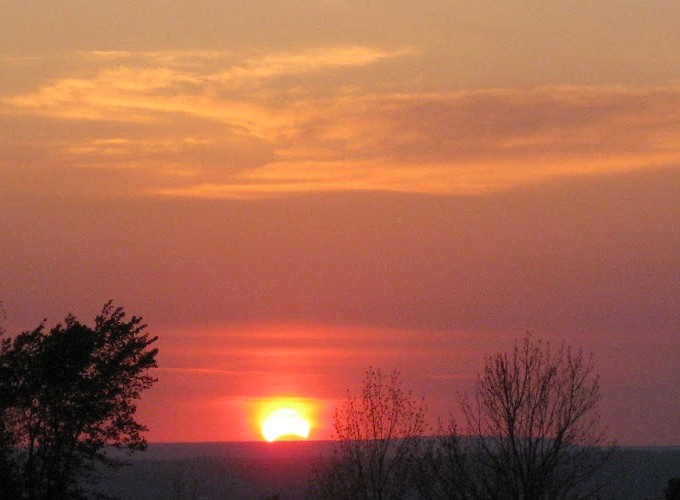
Look closely at the Sun in the image above. You'll notice the curved arc on the bottom of the Sun. That's the Moon. Taken by Blake Nancarrow with a Canon point-and-shoot camera May 2012. 1/400 of a second, f/4.9, focal length 18.6 mm, ISO 400.
The next solar eclipse (technically, occultation) will occur on Thu 23 Oct. It will be another partial for us in south-western Ontario: the Moon will take a bite out of the Sun. From the top edge, this time. The event begins at 5:30 PM and will end, for you, given your sight lines. Sunset is around 6:30 PM. Like the May 2012 partial solar occultation, the Sun will remain blocked as it sets below the western horizon.
safety first!
Lunar eclipses are perfectly safe to view. While the full Moon is bright, the reflected sunlight will not hurt your eyes.
Caution! Viewing the Sun is dangerous. Perhaps more so when the Sun is only partly blocked. If viewing the Sun with binoculars or a telescope, ensure you have a high quality filters on the objective lenses. I.e. light radiation is reduced before it enters the instrument. Ensure the filters cannot be dislodged. Do not use filters only at the eyepiece.
If viewing the Sun with just your eyes, wear high quality solar glasses. If using welder’s glass, ensure it is grade 14 or darker.
planets
Mercury, Mars, Uranus, and Neptune are visible to us this month. Saturn too although it is fading into the twilight.
Mercury is whipping around the Sun. It will be right or west of the Sun, in late October, so visible in the morning, before sunrise. It will be furthest from Sol on Sat 1 Nov. That’s great elongation.
It will also be very high up as the ecliptic or apparent path of the planets in the solar system is canted nearly verticial in the morning this time of year.
Mars is still fairly well placed in the evening sky and continues to move eastward at a good clip. While too far away, and too low in our sky, for resolve surface details, the red planet will still put on a good show. For example, over the 25-26 Oct weekend, Mars will pass under Messier 8 aka the Lagoon Nebula. On the 28th, it will pass very near NGC 6544, a globular cluster. M28 on Nov 2. M22 on Nov 6!
These appulses should be very picturesque. Photo ops!
On top of that, the weekend before, there will be a cometary encounter!
Uranus is close to the earth. The exact day was Tue 7 Oct. Still, it will remain relatively close for some time. That means you have your best chance, in good conditions, and a dark environment, of spotting seventh planet naked eye.
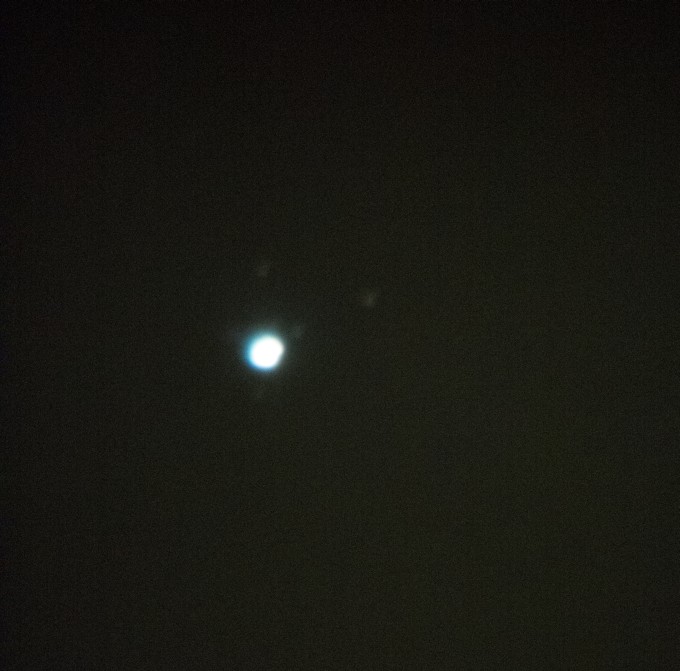
Uranus and moons Oberon, Titania, Umbriel easily spotted. Image by T. dos Santos. Canon 60 Da, eyepiece projection 8.7 mm, CGEM 1100, 42 seconds, unguided, minimal processing.
With the telescope Uranus appears as a pale blue disc or filled circle. Again, when it is close, it’s a good time to try to coax out the brighter moons. Oberon is fairly easy. See the calendar for good opportunities to tag Ariel and Titania.
The dark blue Neptune is also relatively close. Can you see Triton?
comet close and far
There are 3 comets to try for right now.
C/2012 K1 (PANSTARRS) is a morning comet. It should be visible in binoculars at magnitude 7.5. Look in Hydra (left of Canis Major). Getting lower each night. Look now!
C/2013 A1 (Siding Spring) is an evening comet, rising higher in the sky. You’ll want to use a small telescope. It is found in Scorpius at mag 10.2.
After a couple of nights viewing, it will become apparent that it is heading directly toward Mars. From our earthbound vantage, on the weekend of Oct 18-19, they might appear to be colliding; they will get as close as 140 000 km! That's about 1/3rd the distance between the earth and the Moon. Oh, the view from Mars... NASA has reoriented orbitors in preparation.
Finally, try C/2014 E2 (Jacques), another evening comet, visible in small telescopes. You’ll find it high up in Aquila at mag 9.9.
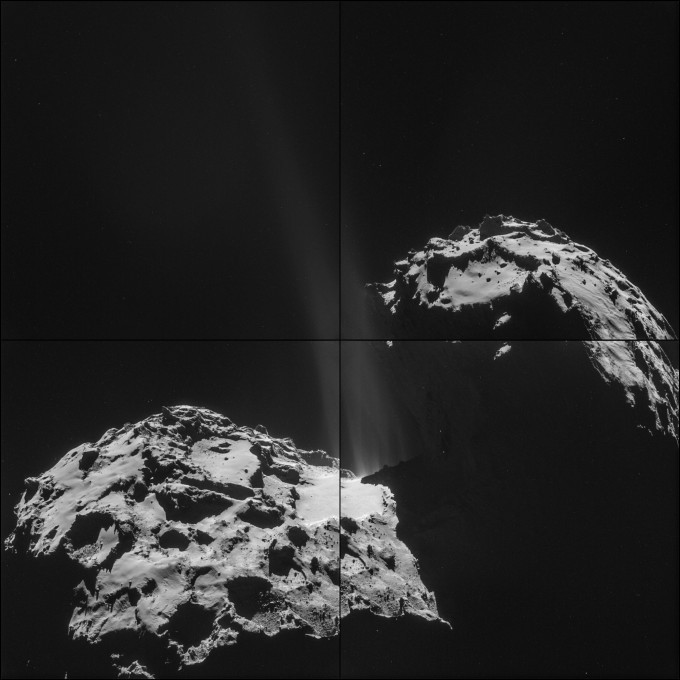
Mosiac image from the ESA, by the Rosetta probe.
The other big comet news is coming from the European Space Agency. The Rosetta craft continues to orbit 67P/Churyumov–Gerasimenko. Just before or during our next Recreational Astronomy Night meeting, the small probe Philae will be released to land on the comet. We will all have front-row seats are the comet tumbles toward the Sun!
deep sky objects
Orion's back! It rises after midnight. If you stay up late, you can enjoy the Great Orion Nebula or M42. The Pleiades in Taurus aka M45 precedes Orion.
Constellations up high in the evening sky include Perseus, Cepheus, Andromeda, Lacerta, and Pegasus.
Some excellent and beautiful deep sky objects to try for include the deep red variable star in Lepus Hind's Crimson Star and the Garnet Star in Cepheus, Bode's Galaxy also known as Messier 81 and the Cigar Galaxy or M82, in Ursa Major, the Turtle Nebula (a planetary) in Hercules, along with the Cat's Eye Nebula in Draco, and the Blue Snowball planetary in Andromeda. Compare them to the Ring and the Dumbbell.
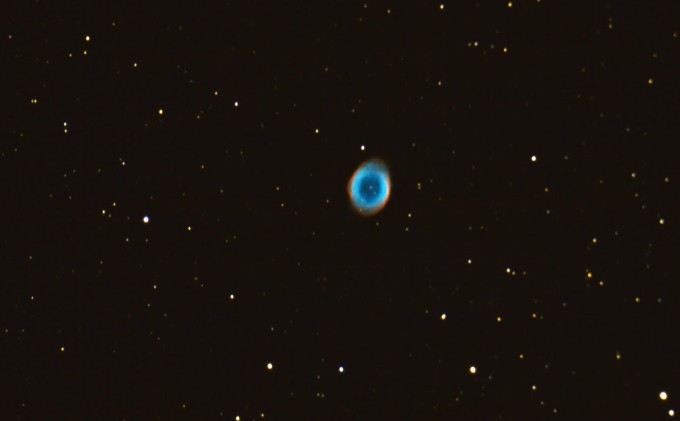
The Ring Nebula aka Messier 57. Images taken with a DSLR on Celestron 14", f/11by G. Seabrook. 1 minute exposures, 30 stacked. Visit the blog for more photos.
If you like open clusters, try M 36, 37, and 38, in Auriga. Off the beaten track are the easy open clusters in Puppis: NGC 2451 and NGC 2477.
Everyone’s favourite, M 13 or the Keystone Cluster, in Hercules is well placed. In dark skies, see if you can locate it with just your eyes. Some prefer the other globular cluster M 15 in Pegasus.
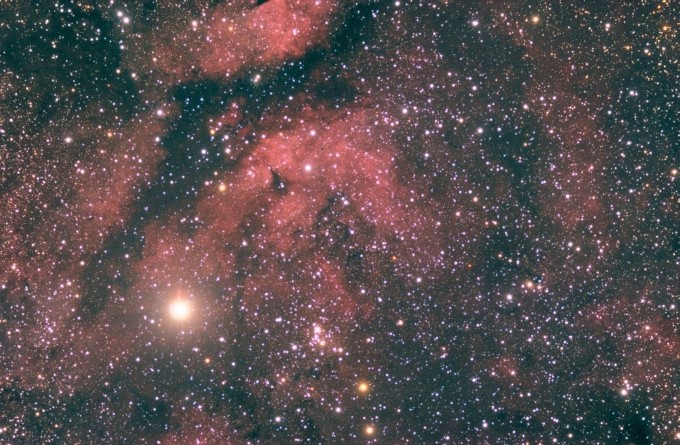
Glowing dust clouds surrounding the centre star of Cygnus, Sadr. Image by R Sewards. Nikon D7000, Orion EON 80mm refractor, HEQ5, guided, 9x10min@ISO1600. See more of Sewards's work.
Strap on the UHC or Oxygen-III filters and absorb the clouds of the North American Nebula or the Pelican, both off the tail feathers of The Swan Cygnus.
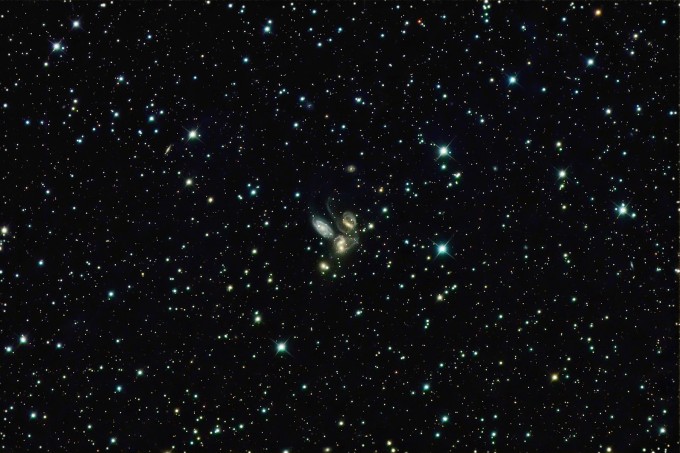
Stephan's Quintet. LRGB image by I. Wheelband from CAO. SBIG STL11000M, 9x900 second luminance, 5x500 secs each colour.
Some challenge galaxies are the small intertwined members of Stephan's Quintet in Pegasus. Be sure to visit NGC 7331. How did Messier miss that one? And again, for a challenge, try to spot on the little galaxies peppered about the large spiral.
Double stars to try for: Almaak in Andromeda, gamma Del, nu Dra, and psi Aqr.
Want to see a naked eye star that hosts exoplanets? A bright easy target is Fomalhaut in Pisces Austrinus.
humans in space
Lots going on at the International Space Station with crews coming and going, Space X and Orbital sending up craft, spacewalks, etc.
There's a launch occurring at Wallops. Sometimes these are, believe it or not, visible from Ontario. Mon 20 Oct.
Remember to check http://heavens-above.com for flyovers of the ISS and other manmade satellites. The calendar notes evening passes of the ISS along with extraordinarily bright Iridiums.
count stars
If you want to help assess light pollution for your area, you can take part in the regular Globe at Night as well as the Great World Wide Star Count.
http://www.globeatnight.org
http://www.windows2universe.org/starcount/
Join the International Dark-Sky Association Toronto chapter’s Facebook book!
https://www.facebook.com/darkskytoronto
Protect our skies.
ode to 12477
Finally, asteroid 12477 also known as asteroid Haiku will pass close to the earth on Nov 7. In honour of the special event, I wrote a message for our small solar system neighbour:
asteroid haiku
please don't crash into the earth
we like it here thanks
the end my friends
The featured image with Orion is by Blake Nancarrow, taken at the Carr Astronomical Observatory late September 2014 around 2:00 AM.
Be seeing you. Contact Blake Nancarrow astronomy at computer-ease dot com for errors, omissions, questions.

